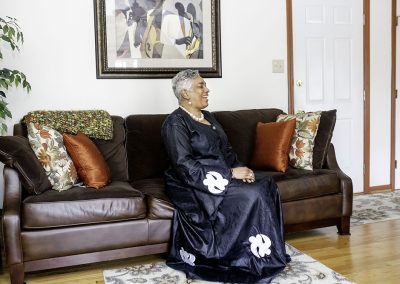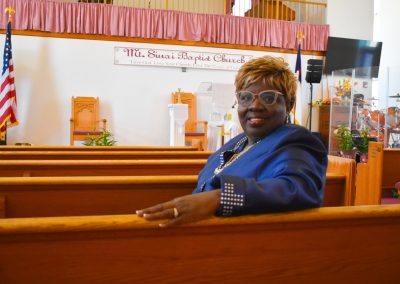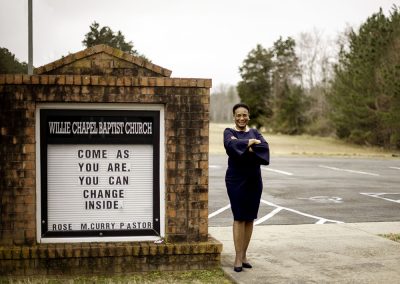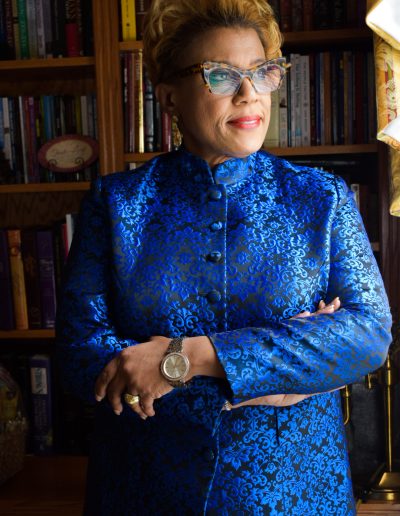See What You Could Be
A Divinity doctoral student celebrates the calling of Black clergywomenBy Claire Cusick
Photography by Savannah Coker and Samia Minnicks
Kaiya Jennings first felt God call her to ministry when she was 16 years old.
She resisted it. She wanted to go to college and have what she thought was the full college experience—so she did.
Then, during her senior year, while in her dorm room at Virginia State University, she felt God call her again.
“I was so lost and so clueless, because growing up in my denomination [National Baptist], I really didn’t see women preaching much,” she said. “I didn’t see them being pastors. I didn’t see them being leaders.”
Relying on God’s Vision
Jennings had watched her mother and grandmother working in the church, managing Sunday school or the feeding ministry, but never preaching. “I never saw women in the pulpit really leading a congregation, a church, preaching the Word, until I was older,” she said.
Jennings had doubts about whether she was worthy of the role. She wondered why God would want her in mission when God could have called anyone else, someone with “a pristine life,” she said. “But that’s just not what I lived. And still God called me.”
This time, Jennings heeded God’s call. She went to seminary, and worked in churches and nonprofit organizations in Virginia. She was licensed to preach eight years ago and ordained to ministry two years ago. She then felt pulled to prepare further, to study spirituality within a Ph.D. program in religion. She applied to several Ph.D. programs close to home, and just one D.Min.—at Duke Divinity School. She felt confident about her chances with the Ph.D. programs. She knew people already enrolled in some. Plus, she had connections and had lined up good recommendation letters.
They all rejected her. “All of the Ph.D. programs said no,” she said. “Every single one.”
Only afterward did she feel the hand of God steering her toward the D.Min. program at Duke. As she reflects on her belief that spiritual commitments should go hand in hand with facts and history, she sees beauty in trying to marry those things together. For her, spirituality is not against history, and she wants eventually to work in higher education. She said yes to Duke. “It has been one of the most rewarding yeses,” she said.
Now Jennings realizes God had a vision for her—a plan that she couldn’t see. “I realize now why God has placed me here: to be a better leader, and also to see what is on the higher education side and how to marry those two things together,” she said. “I’m a better person because of Duke.”
“I love the knowledge that you get from Duke, and also from my cohort. My classmates are my greatest teachers.”
“Here are Black women, leading in these spaces, and taking control and changing the space, and helping people be affirmed. Somebody needs to tell their story. Somebody needs to see them, because if I had women like that when I was younger, maybe I would have been quicker to accept my call . . . I don’t know where I would be now if I had that.”
— Jennings
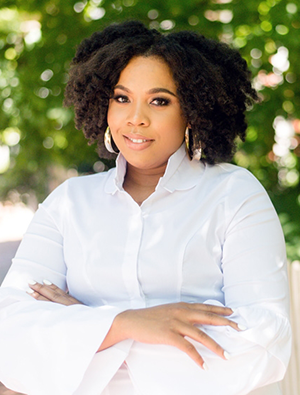
“Here are Black women, leading in these spaces, and taking control and changing the space, and helping people be affirmed. Somebody needs to tell their story. Somebody needs to see them, because if I had women like that when I was younger, maybe I would have been quicker to accept my call . . . I don’t know where I would be now if I had that.”
— Jennings
Expanding Her Vision
Gabby Cudjoe Wilkes, a member of Jennings’ cohort—“I call her my cohort sister”—urged Jennings to apply for the C. Eric Lincoln Fellowship at Duke Chapel. Named for the Duke professor of religion and culture from 1976 to 1993 who was an authority on the sociology of religion as it relates to race and ethnicity in the United States, the fellowship is a semester-long program that provides funding to a Duke student for a sacred art project and invites the fellow to broaden the reach of artistic expression at Duke Chapel. Cudjoe Wilkes knew that Jennings’ work focused on Black clergywomen in leadership, and told her: “This is how you can bring your vision to life.” Jennings was unsure, but she applied anyway.
The fellowship seeks students “whose artistic expressions include one or more of the following: employ theological concepts; illuminate one’s personal faith; display iconography; and engage the topics of gender, race, and religion.” Jennings’ application was successful, and she received funding for a digital and physical exhibition at Duke.
She collaborated with two Virginia photographers, Savannah Coker and Samia Minnicks, to photograph 13 Black clergywomen across the Commonwealth. Each subject is presented twice. The resulting exhibition, On the Shoulders of Our Sisters! was on display at Duke Chapel from May 23 to July 26, 2021 and is also accessible on the Duke Chapel website.
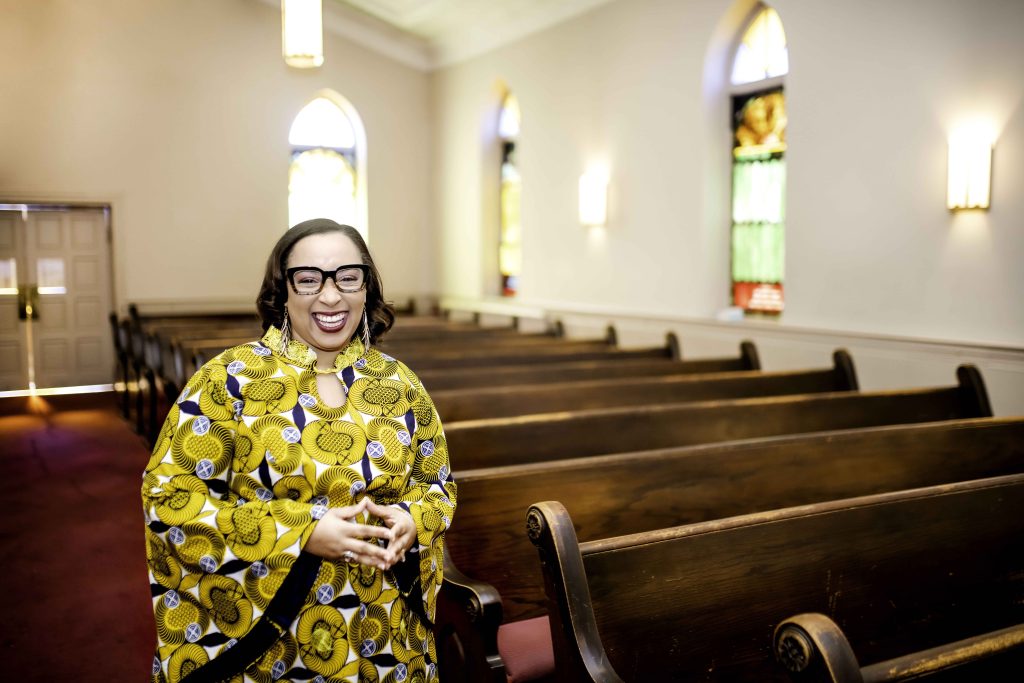
Pastor Littycia Clay-Crawley, Richmond, Virginia. Photographer: Samia Minnicks
Coker is from Jennings’ home church. “I’ve known her since she was a child,” Jennings said. “She has this almost kind of unjaded, raw type of eye.” Jennings wanted the exhibition to include that vision.
Minnicks is a more experienced photographer, with her own Richmond business that works with churches to do their photography. “She has a more polished look,” Jennings said. “A vibrant, colorful type of eye. I wanted both of them because they bring something different.” The resulting photos reflect sharpness, softness, brightness, and darkness. “That really was a moving part for me, because I couldn’t do it myself,” Jennings said. “But that’s part of ministry as well—sharing what you have.”
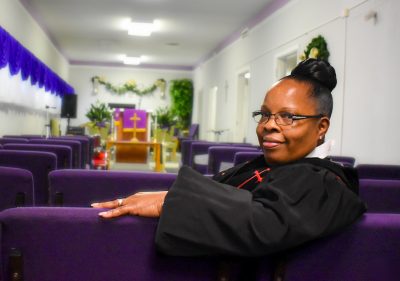
Pastor Anita Lewis, Suffolk, Virginia. Photographer: Savannah Coker
Jennings’ decision to share her vision with the two photographers was an act of generosity, an act of allowing Coker and Minnicks to share how they see. The clergywomen’s ministry is in part what they say, and the photographers’ offering is what they see. “That is beautiful—to allow people to see their own ministry, which is their photography, what they see,” Jennings said.
The clergywomen in the exhibition wear many hats. They are community leaders, lobbyists, and church founders. Each had a role in helping Jennings along her journey in ministry in Virginia, either as a close contact—a former professor, a seminary classmate—or as a woman in ministry embodying the role for Jennings to see, even from afar: speaking at a conference or inviting Jennings to preach.
“Either directly or indirectly, these women have impacted me and opened up my eyes to the point where I realized that God was doing something bigger than me,” Jennings said. “But God also connected me to these people that could hold my hand through the process. And to this very day, that is what they do.”
—Jennings

Bishop Sharma D. Lewis, Glen Allen, Virginia. Photographer: Samia Minnicks
In some cases, the woman was the first woman or first Black woman in her role, just as Jennings was the first woman elected to serve as the youth and young adult director for the Baptist General Convention in Virginia. For instance, Bishop Sharma D. Lewis, resident bishop of the Richmond episcopal area, serves as the first African American woman to be elected bishop in the Southeastern Jurisdiction of the United Methodist Church.
“Either directly or indirectly, these women have impacted me and opened up my eyes to the point where I realized that God was doing something bigger than me,” Jennings said. “But God also connected me to these people that could hold my hand through the process. And to this very day, that is what they do.”
One of the clergywomen, Pastor Anita Lewis, is also a hairdresser. She took care of Jennings’ hair for 20 years, starting when Jennings was just 5 years old. “She also is the first one that told my mom I had a calling on my life, that she should take a look at me, and she should keep an eye on me because God was doing something in my life,” Jennings said.
Another, Rev. Dr. Lacette Cross, leads the first openly affirming church in Richmond. “Here are Black women, leading in these spaces, and taking control and changing the space, and helping people be affirmed,” Jennings said. “Somebody needs to tell their story. Somebody needs to see them, because if I had women like that when I was younger, maybe I would have been quicker to accept my call . . . I don’t know where I would be now if I had that.”
Jennings directed the portrait subjects to dress the way they would for preaching on a Sunday morning. They wear skirts, suits, robes, and even sneakers. Because of COVID, some of the pastors created pulpits in their homes. “I wanted people to see them in their own element,” Jennings said. “And God is pleased, and satisfied, and honored with our true identity. That was so hard for me to grasp early in ministry, because I thought I had to be someone I wasn’t.”
The photographs are full of color and authority and joy. “That was major for me,” Jennings said, “to convey not only that Black women in ministry can hold power, can hold authority, but also this is their calling. And because they know they’re called, it is a joy that’s from within. It’s not anything worldly. It’s a spiritual joy that comes through, it is a God joy, it is a God duty, and I think I wanted people to see that, and just say, My goodness!”
Jennings also included an audio reel of Black women praying to accompany the visual exhibition. These prayers are lifted up by sisters across the country, Jennings said, not just the Virginia clergywomen. “I wanted people to not only just hear those who preach but also hear women in ministry who make up the fabric of this of the spirituality that we hold as Christians.”
In describing these women and their effect on her, Jennings first called it being boxed in by them. Surrounded. But in actuality, she is sitting among them. “Maybe I can change that,” she said. “Maybe [it’s more like] being caped, or canopied, or covered. I was covered by women I didn’t know I needed who showed me how big God was, when I thought God was so small.”
In showing us these women—in allowing us to see and hear them in their fullness—Jennings is showing us chapters of her journey in ministry. And showing us possibility. “I just wanted people to see how amazing Black clergywomen are in the work that they do,” she said.
See Now With New Eyes
Growing up in the church, as the fourth generation to attend First Baptist Church Mahan in Suffolk, Va., Jennings didn’t register what she wasn’t seeing. Virginia remains very traditional, and her denomination remains patriarchal. The pulpit is a sacred space. When it’s a person who looks like you, you wonder: What’s happening? Is this OK?
“That was so hard for me to grasp in ministry, because I thought I had to be somebody I wasn’t,” she said. “I had to realize that no, God called me, just as I am, for me to show up, just as I am.”
Jennings is now deep into the writing process for her thesis, which examines how Black clergywomen lead with their holistic selves.
“I think I was able to accept my call from seeing women in a pulpit,” she said. “When I actually saw women who looked like me, who were young like me, I said, OK, well, I guess, I can do it. I did it.”
Artist Statement
By Kaiya Jennings
This exhibition explores the ministry and faith of Black clergywomen in the Commonwealth of Virginia through audio recordings and photography. The women portrayed in this exhibition lead or pastor in various regions of Virginia, including Northern, Eastern Shore, Central, Hampton Roads, Southern and Southeastern. They have all helped to guide other women in their ministerial callings and have had a direct effect on my own ministry. The images of these women share a visual story that testifies to the fact that no matter the issues that they may face due to factors such as race and gender, they still show up daily to care for those who need them the most, their congregations.
Virginia has a troubled history of issues relating to race, discrimination, and ideologies that perpetuate harm against minority groups. These problems are not limited to secular spaces; they have seeped into the bones of our religious institutions, including the Christian church. From the outside looking in, one would easily believe that within the church, women would occupy roles of power since the entity was built on their shoulders and service for generations. Yet, those in leadership tend to be heterosexual, married men. However, there are countless faithful African American women in Virginia, who have been called and affirmed to pastor churches or to lead as staff pastors and community liaisons, even though they face much opposition.
There are a number of churches and denominations that still believe women should not preach, occupy the pulpit, or be in any type of position of power that will cause them to be over men. The text from the Book of Acts 2:17-18 rebuts this notion: In the last days it will be, God declares, that I will pour out my Spirit upon all flesh, and your sons and your daughters shall prophesy, and your young men shall see visions,?and your old men shall dream dreams. Even upon my slaves, both men and women, in those days I will pour out my Spirit; and they shall prophesy. Much of the patriarchy found within the Christian church can be seen in its traditions, sermonic discourse, staffing, and rituals. Nevertheless, Black clergywomen are still answering the call to ministry and community, despite the opposition faced within their denominations or context.
It is my desire that through this exhibition people will be able to see themselves in the stories and work of these Black clergywomen in such a way that it challenges their faith and increases their love for all humanity.
Artist Statement
By Kaiya Jennings
This exhibition explores the ministry and faith of Black clergywomen in the Commonwealth of Virginia through audio recordings and photography. The women portrayed in this exhibition lead or pastor in various regions of Virginia, including Northern, Eastern Shore, Central, Hampton Roads, Southern and Southeastern. They have all helped to guide other women in their ministerial callings and have had a direct effect on my own ministry. The images of these women share a visual story that testifies to the fact that no matter the issues that they may face due to factors such as race and gender, they still show up daily to care for those who need them the most, their congregations.
Virginia has a troubled history of issues relating to race, discrimination, and ideologies that perpetuate harm against minority groups. These problems are not limited to secular spaces; they have seeped into the bones of our religious institutions, including the Christian church. From the outside looking in, one would easily believe that within the church, women would occupy roles of power since the entity was built on their shoulders and service for generations. Yet, those in leadership tend to be heterosexual, married men. However, there are countless faithful African American women in Virginia, who have been called and affirmed to pastor churches or to lead as staff pastors and community liaisons, even though they face much opposition.
There are a number of churches and denominations that still believe women should not preach, occupy the pulpit, or be in any type of position of power that will cause them to be over men. The text from the Book of Acts 2:17-18 rebuts this notion: In the last days it will be, God declares, that I will pour out my Spirit upon all flesh, and your sons and your daughters shall prophesy, and your young men shall see visions,?and your old men shall dream dreams. Even upon my slaves, both men and women, in those days I will pour out my Spirit; and they shall prophesy. Much of the patriarchy found within the Christian church can be seen in its traditions, sermonic discourse, staffing, and rituals. Nevertheless, Black clergywomen are still answering the call to ministry and community, despite the opposition faced within their denominations or context.
It is my desire that through this exhibition people will be able to see themselves in the stories and work of these Black clergywomen in such a way that it challenges their faith and increases their love for all humanity.

